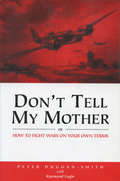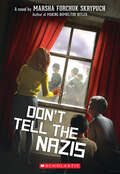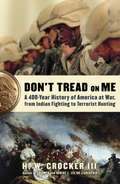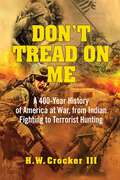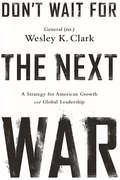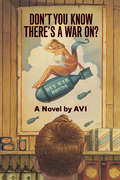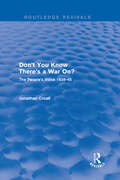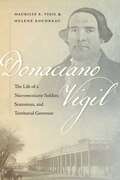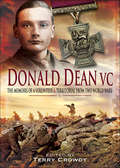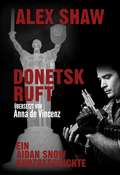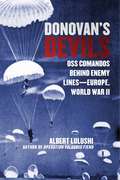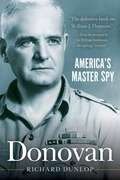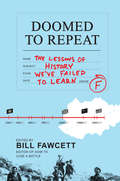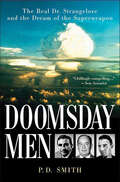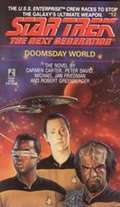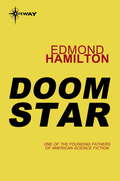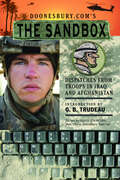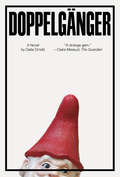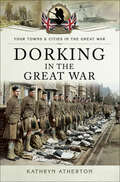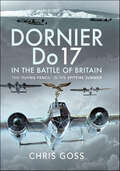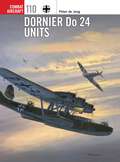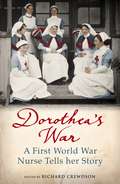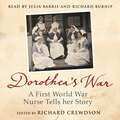- Table View
- List View
Don't Tell My Mother: How to Fight War on Your Own Terms
by Peter Duggan-Smith Raymond EaglePeter Duggan-Smith was born in 1916 to an actress mother. As she was always on the move he was brought up by two maiden aunts until he was accepted to train for a sea-going career on the cadet ship H.M.S. Conway. It was on the last of several voyages to New Zealand as a Merchant Navy apprentice that his life of adventure began — though it did not always turn out as he had planned! The one constant in Peter’s life was his love of flying; by the end of his final flight in Cambodia in 1974, he had racked up more than 17,000 flying hours–in no less than 70 types of piston-engine aircraft. Peter was small in stature, but a giant among adventurers, with a rare ability to take the reader along with him through his many escapades. Raymond Eagle, FSA Scot., is a historian with a particular interest in Scottish and military history. His early years were spent in Eastleigh, Hampshire where, at the age of ten, he had a grandstand view of the Battle of Britain. This gave him a life-long interest in aviation and a great respect for his boyhood heroes, the aircrews of the RAF and Dominion air forces. In 1949 he joined the British army as a national serviceman and was commissioned in the Royal Artillery, spending two years in Hong Kong before continuing in the Territorial Army (Militia). Arriving in Canada in March 1967 with his wife and two young sons, he worked for twenty years in executive positions with various medical charities, writing purely as a hobby. Articles published included such areas as history, environment, health and travel. In November 1991, Eagle’s first book was published in Scotland by Lochar Publishing of Moffat, Seton Gordon — The Life and Times of a Highland Gentleman, a biography of the well-known Scottish naturalist, historian and photographer, who wrote 27 books on the Highlands and Hebrides.
Don't Tell the Nazis
by Marsha Forchuk SkrypuchThe year is 1941. Krystia lives in a small Ukrainian village under the cruel -- sometimes violent -- occupation of the Soviets. So when the Nazis march into town to liberate them, many of Krystia's neighbors welcome the troops with celebrations, hoping for a better life.But conditions don't improve as expected. Krystia's friend Dolik and the other Jewish people in town warn that their new occupiers may only bring darker days.The worst begins to happen when the Nazis blame the Jews for murders they didn't commit. As the Nazis force Jews into a ghetto, Krystia does what she can to help Dolik and his family. But what they really need is a place to hide. Faced with unimaginable tyranny and cruelty, will Krystia risk everything to protect her friends and neighbors?
Don't Tread on Me: A 400-Year History of America at War, from Indian Fighting to Terrorist Hunting
by H. W. Crocker III* Should Patton have been promoted over Eisenhower? * Did the U. S. military win- and Congress lose- the Vietnam War? * Was it right to depose Saddam Hussein- and is it wrong to worry about a possible Iraqi civil war? The answer to these questions is a resounding yes, says author H.W. Crocker III in this stirring and contrarian new book. In Don't Tread on Me, Crocker unfolds four hundred years of American military history, revealing how Americans were born Indian fighters whose military prowess carved out first a continental and then a global empire- a Pax Americana that has been a benefit to the world. From the seventeenth century on, he argues, Americans have shown a jealous regard for their freedom- and have backed it up with an unheralded skill in small-unit combat operations, a tradition that includes Rogers' Rangers, Merrill's Marauders, and today's Special Forces. He shows that Americans were born to the foam too, with a mastery of naval gunnery and tactics that allowed America's Navy, even in its infancy, to defeat French and British warships and expand American commerce on the seas. Most of all, Crocker highlights the courage of the dogface infantry, the fighting leathernecks, and the daring sailors and airmen who have turned the tide of battle again and again. In Don't Tread on Me, still forests are suddenly pierced by the Rebel Yell and a surge of grey. Teddy Roosevelt's spectacles flash in the sunlight as he leads his Rough Riders charging up San Juan Hill. American doughboys rip into close-quarters combat against the Germans. Marines drive the Japanese out of their island fortresses using flamethrowers, grenades, and guts. GIs slug their way into Hitler's Germany. The long twilight struggle against communism is fought in the snows of Korea and the steaming jungles of Vietnam. And today, U. S. Navy SEALs and U.S. Army Rangers battle Islamist terrorists in the bleak mountains of Afghanistan, just as their forebears fought Barbary pirates two hundred years ago. Fast-paced and riveting, Don't Tread on Me is a bold look at the history of America at war.
Don't Tread on Me: A 400-Year History of America at War, from Indian Fighting to Terrorist Hunting
by H. W. Crocker IIIThe Fighting Men Who Made America GreatIn this stirring and contrarian modern classic, bestselling author H. W. Crocker III unfolds four hundred years of American military history, revealing how Americans were born Indian fighters whose military prowess carved out first a continental and then a global empire—a Pax Americana that made the modern world. From the seventeenth century on, he argues, Americans have shown a jealous regard for their freedom—and have backed it up with an unheralded skill in small-unit combat operations, a tradition that includes Rogers&’s Rangers, Merrill&’s Marauders, and today&’s Special Forces. He shows that Americans were born to the foam, too, with a mastery of naval gunnery and tactics that allowed their navy, even in its infancy, to defeat French and British warships and expand U.S. commerce on the seas. Most of all, Crocker highlights the courage of the dogface infantry, the fighting leathernecks, and the daring sailors and airmen who have turned the tide of battle again and again. In Don&’t Tread on Me, still forests are suddenly pierced by the Rebel Yell and a surge of grey. Teddy Roosevelt&’s spectacles flash in the sunlight as he leads his Rough Riders&’ charge up San Juan Hill. Yankee doughboys rip into close-quarters combat against the Germans. Marines drive the Japanese out of their island fortresses with flamethrowers, grenades, and guts. GIs slug their way into Hitler&’s Germany. The long twilight struggle against communism is fought in the snows of Korea and the steaming jungles of Vietnam. Navy SEALs and Army Rangers battle Islamist terrorists in the bleak mountains of Afghanistan, just as their forefathers fought Barbary pirates two hundred years ago. And we are reminded of the wisdom of America&’s greatest generals: George Washington, Andrew Jackson, Robert E. Lee, Ulysses Grant, John Pershing, George Patton, Douglas MacArthur, and Norman Schwarzkopf. Fast-paced and riveting—and completely updated from its original 2006 publication—Don&’t Tread on Me is a bold look at the history of America at war.
Don't Wait for the Next War: A Strategy for American Growth and Global Leadership
by Wesley K. ClarkWith the end of the Cold War came not the end of history, but the end of America’s sense of its strategic purpose in the world. Then, after a decade of drift, the US was violently dragged back into international conflict. Its armed forces responded magnificently but its leaders’ objectives were substantially flawed. We fought the wrong war-twice-for reasons that were opaque, and few American citizens understood the cause for which their sons and daughters were fighting and dying. War is a poor substitute for strategic vision, and decisions made in the heat of imminent conflict are often limited by the emotions of the moment. In Don’t Wait for the Next War, Wesley K. Clark, a retired four-star general of the US army and former Democratic candidate for president, presents a compelling argument for continued American global leadership and the basis on which it can succeed-a new American strategy. America needs both new power and deeper perspective. The platform for American leadership is to use America’s energy resources to spark sustainable economic growth, building new strength to deal with pressing domestic issues like the deficit as well as the longer term challenges to US security-terrorism, cyber threats, the next financial crisis, China’s rising power, and climate change. Such a strategy is not only achievable but essential, and it is urgently needed. This is the true test of American leadership for the next two decades, but it must start now, so America has the power and vision to deal with the acute crises that will inevitably come-in the Mideast, Europe, or Asia.
Don't You Know There's a War On?
by AviWorld War II is on everyone's mind and in every headline, and Howie Crispers has a hunch that his school principal is a spy. With a little snooping around, Howie finds out something even more alarming. Principal Lomister may not be a spy, but he is plotting to get rid of Howie's favorite teacher. Howie's dad is fighting Nazis overseas, and his mom is working hard to support the war effort, so Miss Gossim is the only person Howie can depend on. With the help of his friends, and a plan worthy of radio show superhero Captain Midnight, Howie intends to save Miss Gossim!
Don't You Know There's a War On?: The People's Voice 1939-45 (Routledge Revivals)
by Jonathan CroallWas the country really united in the face of the common enemy? Did people actually put the community’s needs before their own? Or were such ideas simply a series of myths created at the time and nurtured ever since. The recollections of this book, first published in 1989, attempt to answer such questions by evoking the reality of life on the home front during the war years. Here is a uniquely personal portrait of a nation at war, extensively illustrated with photographs, diaries, letters, poems, and other memorabilia belonging to the men and women whose wartime lives fill this absorbing book. This title will be of interest to students of history.
Donaciano Vigil: The Life of a Nuevomexicano Soldier, Statesman, and Territorial Governor
by Helene Boudreau Maurilio E. VigilBorn in Santa Fe in 1802, Donaciano Vigil was an active participant in many of the critical events in New Mexico&’s history in the nineteenth century. Vigil was witness to New Mexico&’s transition from a Spanish province (1802–1821) to a Mexican department (1821–1846) and eventually to an American territory (1846–1877), and he was a key player in most of the events of that era. As a Hispano soldier and officer in the New Mexico Militia, he was instrumental in the Navajo Wars, the Rio Arriba insurrection of 1837, the Texas invasion of 1841, and the American invasion of 1846. As a Mexican statesman in New Mexico, he was one of the most active assemblymen. Following the American occupation, he joined the civil government, first as secretary, then as governor. It was in these roles that Donaciano left an enduring impact and legacy on the territory.In this gripping biography of a remarkable man, Maurilio E. Vigil and Helene Boudreau fill the gap within the scholarship on Hispanics in nineteenth-century New Mexico.
Donald Dean VC: The Memoirs of a Volunteer & Territorial from Two World Wars
by Terry Crowdy Susan BavinDonald Dean lied about his age to enlist in the Queen's Own Royal West Kent Regiment and serve on the Western Front, where he worked his way up from Private to acting Captain. It was in the last weeks of the war, late in September 1918, that he won his VC for leading a platoon in the determined defense of a recently captured and isolated trench against repeated German counterattacks. In one of these attacks, the Germans actually broke into the trench, forcing Dean to break off a radio call for artillery support with the words 'The Germans are here, goodbye!' Refusing to be overrun, he personally killed four of the Germans before they were finally evicted. Dean also served in World War II, witnessing the fall of France in 1940 and claiming to be the last Brit to get out of Boulogne. His frank account of the evacuation challenges some cherished conceptions and is very critical of the conduct of the Irish Guards in particular. He went on to fight in Madagascar, Sicilya and the Italian mainland. Donald Dean died in 1985.Military historian Terry Crowdy has edited Dean's letters and diaries, never previously published, adding additional notes and material from official reports to give the reader context. The result is a moving, often amusing and inspiring portrait of a little-known hero of two world wars.
Donetsk Ruft
by Alex Shaw Anna De VincenzDer ehemalige SAS-Soldat, jetzt MI6 Agent Aidan Schnee kehrt in einer Kurzgeschichte zurück. Als ein Expat hat Brian Webb ein tolles Leben, eine sexy Frau und eine perfekte Tochter. Aber all dies wird in Gefahr gebracht, als er auf dem Weg nach Hause nach einer durchzechten Nacht von einer Gruppe bewaffneter Angreifer gejagte wird. Wer sind seine Verfolger, was wollen sie von ihm, und warum schießen sie? Webb will lieber nicht bleiebn um dies herauszufinden. Ein gestohlenes Auto wird zu Schrott gefahren beim Versuch zu entkommen und Webb wird blutig geschlagen, in die Enge getrieben und hat keine Optionen mehr... ohne eine andere Wahl, ruft er die einzige Person an, die ihn nie im Stich lassen würde. Er ruft Aidan Snow an. In Kiew angekommen, nimmt Snow das Gesetz in die eigene Hand in einem Versuch einen seiner ältesten Freunde zu finden und zu retten. Mit den Geistern der Vergangenheit auf seinen Schultern muss Snow sich wieder auf seinen SAS Training verlassen und wird nicht aufhören , bis er die Wahrheit erfährt.
Donovan's Devils: OSS Commandos Behind Enemy Lines—Europe, World War II
by Albert LulushiThe stirring, little-known story of the forerunners to today's Special Forces. The OSS--Office of Strategic Services--created under the command of William Donovan, has been celebrated for its cloak-and-dagger operations during World War II and as the precursor of the CIA. As the "Oh So Social," it has also been portrayed as a club for the well-connected before, during, and after the war. Donovan's Devils tells the story of a different OSS, that of ordinary soldiers, recruited from among first- and second-generation immigrants, who volunteered for dangerous duty behind enemy lines and risked their lives in Italy, France, the Balkans, and elsewhere in Europe. Organized into Operational Groups, they infiltrated into enemy territory by air or sea and operated for days, weeks, or months hundreds of miles from the closest Allied troops. They performed sabotage, organized native resistance, and rescued downed airmen, nurses, and prisoners of war. Their enemy showed them no mercy, and sometimes their closest friends betrayed them. They were the precursors to today's Special Forces operators. Based on declassified OSS records, personal collections, and oral histories of participants from both sides of the conflict, Donovan's Devils provides the most comprehensive account to date of the Operational Group activities, including a detailed narrative of the ill-fated Ginny mission, which resulted in the one of the OSS's gravest losses of the war. Skyhorse Publishing, as well as our Arcade imprint, are proud to publish a broad range of books for readers interested in history--books about World War II, the Third Reich, Hitler and his henchmen, the JFK assassination, conspiracies, the American Civil War, the American Revolution, gladiators, Vikings, ancient Rome, medieval times, the old West, and much more. While not every title we publish becomes a New York Times bestseller or a national bestseller, we are committed to books on subjects that are sometimes overlooked and to authors whose work might not otherwise find a home.
Donovan: America?s Master Spy
by Richard Dunlop William Stephenson<P>One of the most celebrated and highly decorated heroes of World War I, a noted trial lawyer, presidential adviser and emissary, and chief of America's Office of Strategic Services during World War II, William J. Donovan was a legendary figure. Donovan, originally published in 1982, penetrates the cloak of secrecy surrounding this remarkable man. <P>During the dark days of World War II, "Wild Bill" Donovan, more than any other person, was responsible for what William Stevenson, author of A Man Called Intrepid, described as "the astonishing success with which the United States entered secret warfare and accomplished in less than four years what it took England many centuries to develop." <P>Drawing upon Donovan's diaries, letters, and other papers; interviews with hundreds of the men and women who worked with him and spied for him; and declassified and unpublished documents, author Richard Dunlop, himself a former member of Donovan's OSS, traces the incredible career of the man who almost single-handedly created America's central intelligence service. The result is the definitive biography that Donovan himself had always expected Dunlop would write. <P><b>A New York Times Bestseller</b>
Doomed to Repeat: The Lessons of History We've Failed to Learn
by Bill Fawcett“Those who forget history are doomed to repeat it.” And so we have. Time and again, mankind has faced down problems, but have often failed to take the hard-earned knowledge into the next battle. Doomed to Repeat is a collection of essays, edited by Bill Fawcett, that illuminates some of the problems we've faced repeatedly throughout history, including Islamic jihad, terrorism, military insurgencies, inflation and the devaluation of currency, financial disasters, ecological collapses, radical political minorities like the Nazis and Bolsheviks, and pandemics and epidemics like the Black Death. With more than 35 chapters of the Groundhog Days of world history, both infamous and obscure, Doomed to Repeat: The Lessons of History We've Failed to Learn is chock-full of trivia, history, and fascinating looks at the world’s repeated mistakes.
Doomsday Men: The Real Dr. Strangelove and the Dream of the Superweapon
by P. D. SmithThis is the gripping, untold story of the doomsday bomb—the ultimate weapon of mass destruction. In 1950, Hungarian-born scientist Leo Szilard made a dramatic announcement on American radio: science was on the verge of creating a doomsday bomb. For the first time in history, mankind realized that he had within his grasp a truly God-like power, the ability to destroy life itself. The shockwave from this statement reverberated across the following decade and beyond. If detonated, Szilard's doomsday device—a huge cobalt-clad H-bomb—would pollute the atmosphere with radioactivity and end all life on earth. The scientific creators of such apocalyptic weapons had transformed the laws of nature into instruments of mass destruction and for many people in the Cold War there was little to distinguish real scientists from that "fictional master of megadeath," Stanley Kubrick's Dr. Strangelove. Indeed, as PD Smith's chilling account, Doomsday Men, shows, the dream of the superweapon begins in popular culture. This is a story that cannot be told without the iconic films and fictions that portray our deadly fascination with superweapons, from H.G. Wells' The War of the Worlds to Nevil Shute's On the Beach and Kubrick's Dr. Strangelove or: How I Learned to Stop Worrying and Love the Bomb. Although scientists admitted it was possible to build the cobalt bomb, no superpower would admit to having created one. However, it remained a terrifying possibility, striking fear into the hearts of people around the world. The story of the cobalt bomb is an unwritten chapter of the Cold War, but now PD Smith reveals the personalities behind this feared technology and shows how the scientists responsible for the twentieth century's most terrible weapons grew up in a culture dreaming of superweapons and Wellsian utopias. He argues that, in the end, the doomsday machine became the ultimate symbol of humanity's deepest fears about the science of destruction.
Doomsday World (Star Trek: The Next Generation #12)
by Michael Jan Friedman Robert Greenberger Peter David Carter CarmenThe planet Kirlos -- an artificial world built by a mysterious long-dead race called the Ariantu. Kirlos is now home to many races from both the Federation and the K'vin Hegemony, who have enjoyed years of peaceful co-existence and profitable trade. The planet also hold a wealth of undiscovered archaeological treasures, which the Enterprise and its crew are dispatched to help uncover. Sent to the surface to assist an archaeological team, Geordi, Data, and Worf soon find themselves cut off from the Enterprise -- and the prime suspects in a series of terrorist attacks. The three Enterprise crewmen are imprisoned, relations between the K'vin and the Federation begin to crumble, and Kirlos' ancient underground machinery awakens from a centuries long dormancy, primed to release the most powerful destructive force ever known.
Doomstar
by Edmond HamiltonThe sun shone brightly on this fateful morning, bringing to its planets warmth and life-giving rays. The brightness increased sharply as the morning grew older. The glare was blinding; the radiation not life-giving, but deadly. By mid-afternoon the brilliant, intense sun shone on barren space. It had blasted each of its four planets out of existence. Someone had found a way to poison a star. And someone had to be found who could prevent the takeover - or destruction - of the entire universe. Who? Johnny Kettrick, as improbable a hero there never was. Johnny Kettrick who was banned from the Cluster World for his not-too-honest dealings was sent back there with his three equally unholy partners to search out the Doomstar...to find the Doomstar before it burned out another world.
Doonesbury.com's The Sandbox: Dispatches from Troops in Iraq and Afghanistan (Doonesbury)
by David StanfordAn anthology of stories from American servicemembers in Iraq and Afghanistan from the military blog launched by the creator of Doonesbury.In 2006, Gary Trudeau launched The Sandbox, an online forum where service members in could share their stories with readers at home. In hundreds of compelling posts, soldiers wrote movingly of their day-to-day lives, of their mission, and of the drama that unfolds daily around them.A dog adopts a unit on patrol in Baghdad and guards its flank; a soldier chronicles an epic day of close-call encounters with IEDs; an Afghan translator talks earnestly with his American friend about love and theology; a dad far from home meditates on time and history in the desert night under ancient stars; a Chuck Norris action figure witnesses surreal moments of humor in the cramped cab of a Humvee. Doonesbury.com's The Sandbox presents a rich outpouring of stories, from the hilarious to the thrilling to the heartbreaking, and helps us understand what so many of our countrymen go through on the frontlines.
Doppelgänger
by Daša DrndicLonglisted for the Republic of Consciousness Prize 2019, a swift, biting novel from the late Croatian master, Dasa Drndic Two elderly people, Artur and Isabella, meet and have a passionate sexual encounter on New Year’s Eve. Details of the lives of Artur, a retired Yugoslav army captain, and Isabella, a Holocaust survivor, are revealed through police dossiers. As they fight loneliness and aging, they take comfort in small things: for Artur, a collection of 274 hats; for Isabella, a family of garden gnomes who live in her apartment. Later, we meet the ill-fated Pupi, who dreamed of becoming a sculptor but instead became a chemist and then a spy. As Eileen Battersby wrote, “As he stands, in the zoo, gazing at a pair of rhinos, in a city most likely present-day Belgrade, this battered Everyman feels very alone: ‘I would like to tell someone, anyone, I’d like to tell someone: I buried Mother today.’” Pupi sets out to correct his family’s crimes by returning silverware to its original Jewish owners through the help of an unlikely friend, a pawnbroker. Described by Dasa Drndic as “my ugly little book,” Doppelgänger was her personal favorite.
Dorking in the Great War (Your Towns & Cities in the Great War)
by Kathryn AthertonFrom Zeppelin raids to housing refugees and evacuees or from men volunteering to fight or women working in the local Gunpowder factory, Dorking in the Great War looks at how the experience of war impacted on the town, from the initial enthusiasm for sorting out the German Kaiser in time for Christmas 1914, to the gradual realization of the enormity of human sacrifice the families of Dorking were committed to as the war stretched out over the next four years. The Great War affected everyone. At home there were wounded soldiers in military hospitals, refugees from Belgium and later on German prisoners of war. There were food and fuel shortages and disruption to schooling. The role of women changed dramatically and they undertook a variety of work undreamed of in peacetime. Meanwhile, men serving in the armed forces were scattered far and wide. Extracts from contemporary letters reveal their heroism and give insights into what it was like under battle conditions.
Dornier Do 17 in the Battle of Britain: The 'Flying Pencil' in the Spitfire Summer
by Chris GossIn this comprehensive pictorial record of the Do 17, the bomber’s role throughout the period of the Battle of Britain is displayed in the author’s unique collection of British and German photographs.During Britain’s desperate struggle for survival that in the summer of 1940, the Dornier Do 17 played a prominent part in raids designed at neutralizing the RAF’s ability to resist and the British people’s will to fight back. Having been built to outrun contemporary fighters when introduced into the Luftwaffe in 1937, it had become the Luftwaffe’s main light bomber, and for the attack against Britain, three bomber wings, KG 2, KG3 and KG77, were equipped with the Do 17. But by 1940, the Do 17 was nearing obsolescence and, with its weak defensive armament, it fell prey to Fighter Command’s Hurricanes and Spitfires. Its vulnerability was starkly revealed on 18 August 1940, when eight Dorniers were shot down and nine damaged in attacks on RAF Kenley, and on 15 September – Battle of Britain Day – when twenty were shot down and a further thirteen damaged. On that day, Sergeant Ray Holmes rammed his Hurricane into a Do 17 that was reportedly aiming for Buckingham Palace. Part of the bomber’s wreckage fell to earth near Victoria Station. In this comprehensive pictorial record of the Do 17, the bomber’s role throughout the period of the Battle of Britain is displayed in the author’s unique collection of British and German photographs. These photographs, coupled with first-hand stories from those who flew and those who fought against the Do 17, bring those desperate days and dark nights back to life in the manner which only contemporary images and accounts can achieve.
Dornier Do 24 Units
by Chris Davey Peter JongPerhaps the most seaworthy flying boat ever built, the elegant, tri-motor Dornier Do 24 served with both the Allied and Axis forces in very different parts of the globe during World War II, garnering an excellent reputation along the way This study uses archival records, first-hand accounts and revealing photographs to illuminate the combat career of this remarkable aircraft for the first time in English. The German-built Do 24 was the Netherlands Navy's principal aerial asset during the Japanese invasion of the East Indies. While the survivors of that ordeal served in the Australian Air force, in occupied Holland and France production continued swiftly and the Do 24 equipped the German Air-Sea rescue service, whose crews loved and respected the machine. The type witnessed the rise and fall of the Luftwaffe over all the European seas, took part in the desperate evacuations of Wehrmacht troops on the Baltic in the face of the overwhelming Soviet advance, and was pressed out of service only with the withdrawal of Spanish Do 24s in 1969. This volume tells the long and eventful story of the faithful Do 24 in full.
Dorothea's War: The Diaries of a First World War Nurse
by Dorothea CrewdsonThe evocative diaries of a young nurse stationed in northern France during the First World War, published for the first time. A rare insight into the great war for fans of CALL THE MIDWIFE.In April 1915, Dorothea Crewdson, a newly trained Red Cross nurse, and her best friend Christie, received instructions to leave for Le Tréport in northern France. Filled with excitement at the prospect of her first paid job, Dorothea began writing a diary. 'Who knows how long we shall really be out here? Seems a good chance from all reports of the campaigns being ended before winter but all is uncertain.'Dorothea would go on to witness and record some of the worst tragedy of the First World War at first hand, though somehow always maintaining her optimism, curiosity and high spirits throughout. The pages of her diaries sparkle with warmth and humour as she describes the day-to-day realities and frustrations of nursing near the frontline of the battlefields, or the pleasure of a beautiful sunset, or a trip 'joy-riding' in the French countryside on one of her precious days off. One day she might be gossiping about her fellow nurses, or confessing to writing her diary while on shift on the ward, or illustrating the scene of the tents collapsing around them on a windy night in one of her vivid sketches. In another entry she describes picking shells out of the beds on the ward after a terrifying air raid (winning a medal for her bravery in the process).Nearly a hundred years on, what shines out above all from the pages of these extraordinarily evocative diaries is a courageous, spirited, compassionate young woman, whose story is made all the more poignant by her tragically premature death at the end of the war just before she was due to return home.
Dorothea's War: The Diaries of a First World War Nurse
by Dorothea CrewdsonThe evocative diaries of a young nurse stationed in northern France during the First World War, published for the first time. A rare insight into the great war for fans of CALL THE MIDWIFE.In April 1915, Dorothea Crewdson, a newly trained Red Cross nurse, and her best friend Christie, received instructions to leave for Le Tréport in northern France. Filled with excitement at the prospect of her first paid job, Dorothea began writing a diary. 'Who knows how long we shall really be out here? Seems a good chance from all reports of the campaigns being ended before winter but all is uncertain.'Dorothea would go on to witness and record some of the worst tragedy of the First World War at first hand, though somehow always maintaining her optimism, curiosity and high spirits throughout. The pages of her diaries sparkle with warmth and humour as she describes the day-to-day realities and frustrations of nursing near the frontline of the battlefields, or the pleasure of a beautiful sunset, or a trip 'joy-riding' in the French countryside on one of her precious days off. One day she might be gossiping about her fellow nurses, or confessing to writing her diary while on shift on the ward, or illustrating the scene of the tents collapsing around them on a windy night in one of her vivid sketches. In another entry she describes picking shells out of the beds on the ward after a terrifying air raid (winning a medal for her bravery in the process).Nearly a hundred years on, what shines out above all from the pages of these extraordinarily evocative diaries is a courageous, spirited, compassionate young woman, whose story is made all the more poignant by her tragically premature death at the end of the war just before she was due to return home.
Dorothea's War: The Diaries of a First World War Nurse
by Dorothea CrewdsonIn April 1915, Dorothea Crewdson, a newly trained Red Cross nurse, and her best friend Christie, received instructions to leave for Le Tr port in northern France. Filled with excitement at the prospect of her first paid job, Dorothea began writing a diary. 'Who knows how long we shall really be out here? Seems a good chance from all reports of the campaigns being ended before winter but all is uncertain.'Dorothea would go on to witness and record some of the worst tragedy of the First World War at first hand, though somehow always maintaining her optimism, curiosity and high spirits throughout.The pages of her diaries sparkle with warmth and humour as she describes the day-to-day realities and frustrations of nursing near the frontline of the battlefields, or the pleasure of a beautiful sunset, or a trip 'joy-riding' in the French countryside on one of her precious days off. One day she might be gossiping about her fellow nurses, or confessing to writing her diary while on shift on the ward, or illustrating the scene of the tents collapsing around them on a windy night in one of her vivid sketches. In another entry she describes picking shells out of the beds on the ward after a terrifying air raid (winning a medal for her bravery in the process).Nearly a hundred years on, what shines out above all from the pages of these extraordinarily evocative diaries is a courageous, spirited, compassionate young woman, whose story is made all the more poignant by her tragically premature death at the end of the war just before she was due to return home.Read by Julia Barrie and Richard Burnip(p) 2015 Orion Publishing Group
